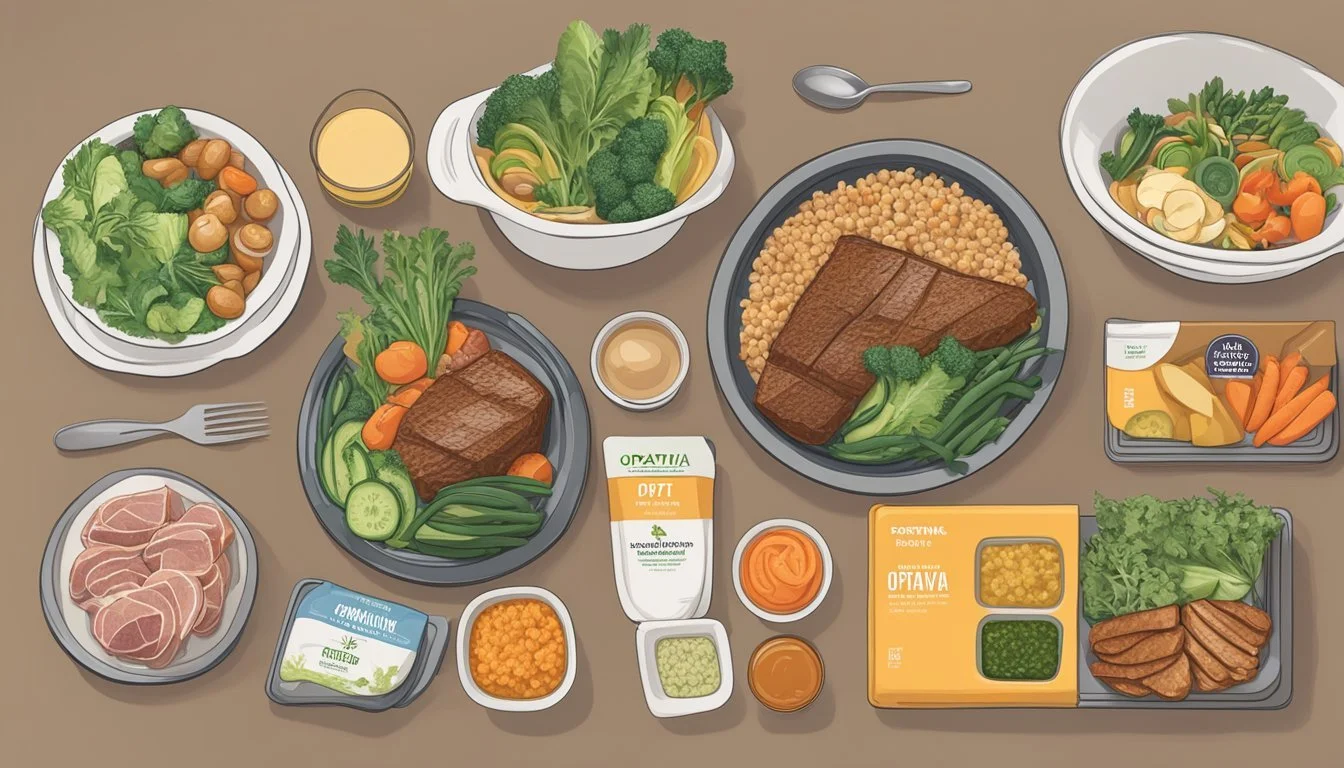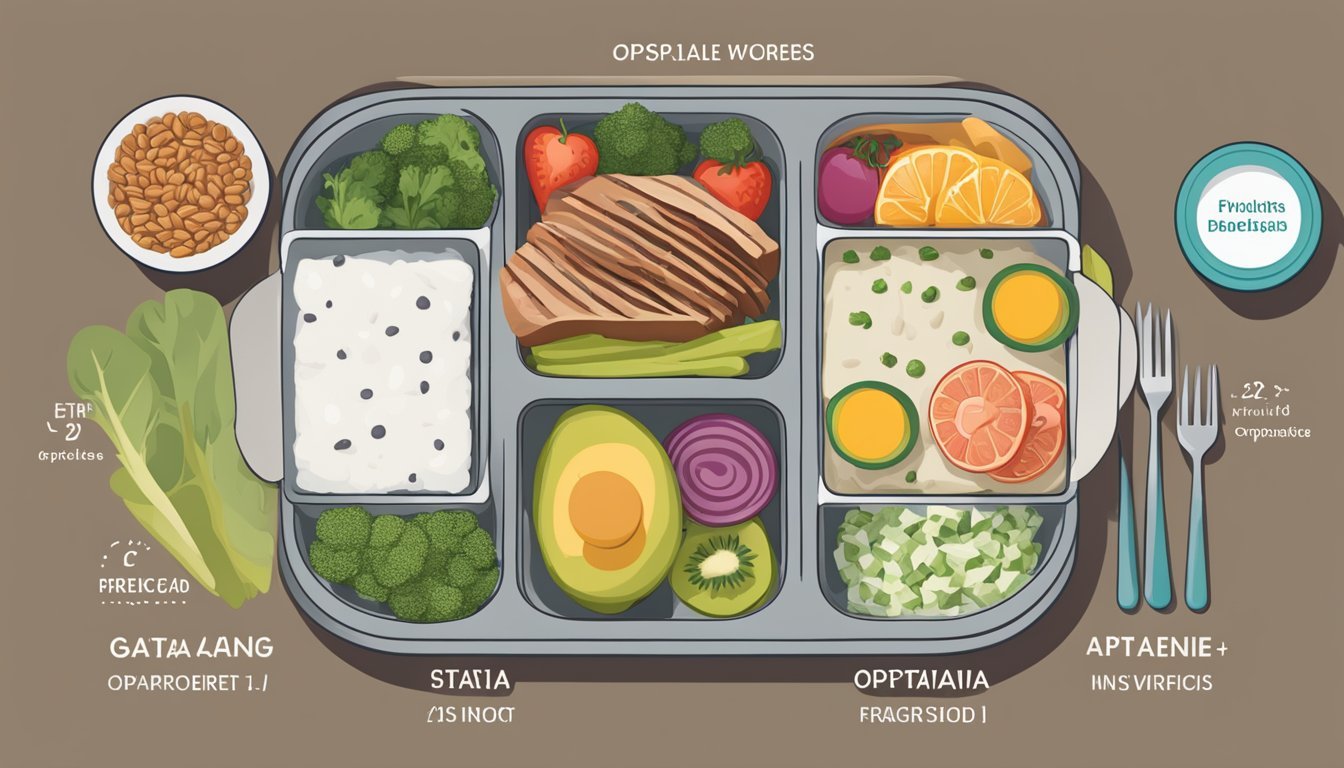Carnivore Diet vs. The Optavia Diet
Comparing Prepackaged Convenience to Whole Food Nutrition
The Carnivore Diet and the Optavia Diet stand as contrasting paradigms in the diverse landscape of nutritional strategies, each representing disparate approaches to weight loss and a healthy lifestyle. Where the Carnivore Diet promotes an all-animal-product eating plan, relying heavily on meat and other animal foods, the Optavia Diet leans towards a more structured format, utilizing prepackaged meals and specific guidelines to propel its followers toward their weight loss goals. The former advocates for whole foods and simplicity, while the latter underscores the convenience and discipline of a programmatic approach to dieting.
Both diets have their own set of proponents who attest to their effectiveness, yet they cater to different preferences and lifestyles. The Carnivore Diet appeals to those who appreciate a more straightforward, albeit restrictive, approach to eating and may favor the potential benefits of high protein and low-carbohydrate intake. On the other hand, the Optavia Diet captures the attention of individuals seeking a guided, convenient, and often community-supported weight loss journey, offering a regimen that includes multiple "fuelings" throughout the day combined with one self-prepared meal.
Navigating these diets requires an understanding of personal health goals, nutritional needs, and lifestyle compatibility. While one diet emphasizes the elimination of all but animal products, the other involves a more prescriptive and varied diet structure. These differences reflect the uniqueness of each approach and how each diet's principles align with individual weight loss and health objectives.
Understanding the Carnivore Diet
The Carnivore Diet consists exclusively of animal products and is a high-protein, high-fat diet with a central claim of improved health through a reduction in plant-based foods.
Fundamentals of Carnivore Diet
The Carnivore Diet is centered on the consumption of animal products including meat, fish, eggs, and sometimes dairy. Proponents assert that this diet mimics the eating patterns of ancestral humans. It is an elimination diet, excluding all plant-based foods and thus, is completely devoid of carbohydrates. This diet focuses primarily on red and white meats, embracing both fatty and lean cuts, and encourages the consumption of organ meats for their nutrient density.
Key Components:
Proteins and Fats: The primary source of energy and nutrition.
Animal Products: Sole food items consumed on this diet.
Exclusion of Carbohydrates: No fruits, vegetables, nuts, or seeds.
Benefits of Carnivore Diet
Individuals following the Carnivore Diet may experience weight loss due to lower insulin levels and a decreased appetite. The diet is rich in proteins, which can lead to increased satiety. It provides essential fats, vitamins, and minerals required for the body's functions. Advocates report improvements in mood and mental clarity, although these claims are anecdotal.
Reported Benefits:
Weight Loss: Potentially due to higher satiety and reduced caloric intake.
Mental Clarity: Some individuals experience increased focus and mood stabilization.
Nutrient-Dense Foods: Organ meats are particularly rich in nutrients.
Risks and Considerations
Despite the potential benefits, the Carnivore Diet carries substantial risks and is a subject of controversy among nutrition experts. Consuming large amounts of saturated fat can increase the risk of heart disease. The diet may also lead to deficiencies in certain nutrients found in plant foods, strain the kidneys due to high protein intake, and negatively impact gut health as a result of low fiber intake. Individuals with diabetes, high blood pressure, or other health conditions should consult a healthcare provider before starting this diet.
Considerations and Risks:
Heart Disease: High intake of saturated fat may increase the risk.
Nutritional Deficiencies: Potential lack of fiber and some vitamins and minerals.
Health Conditions: People with existing health issues should exercise caution.
Understanding the Optavia Diet
The Optavia Diet is a structured diet program that emphasizes prepackaged meals, referred to as "fuelings," supplemented by homemade "lean and green" meals. This approach is designed for weight management and includes one-on-one coaching.
Fundamentals of Optavia Diet
The Optavia Diet is a commercial diet plan developed by Medifast. It primarily involves consuming a series of specifically formulated fuelings—over 60 options that include bars, shakes, and other snacks. Each fueling is designed to provide a balance of protein, carbohydrates, and fiber while being low-calorie. In addition to these meal replacements, the diet incorporates one homemade meal daily, known as a "lean and green" meal, consisting of vegetables, lean protein, and a portion of healthy fats.
Essential Fuelings: These include a variety of products rich in protein and fiber.
Lean and Green Meals: Include 5–7 ounces of cooked lean protein, three servings of non-starchy vegetables, and up to two servings of healthy fats.
Benefits of Optavia Diet
Individuals may experience weight loss due to the low-calorie nature of the prepackaged fuelings and controlled portions of the "lean and green" meals. The diet simplifies meal planning, which can benefit those who find organizing meals challenging. Moreover, the inclusion of regular coaching can provide support and motivation. Some studies indicate that following this diet can lead to improvements in blood lipid profiles and blood glucose levels, which can be advantageous for individuals with diabetes.
Weight Management: Reduced calorie intake aims to promote weight loss.
Simplification: Prepackaged meals may help reduce the complexity of dieting.
Coaching: Professional guidance can enhance adherence to the diet.
Risks and Considerations
While the Optavia Diet offers convenience, it also raises cost considerations as it can be more expensive than traditional meal planning. The reliance on prepackaged meals may not encourage the development of sustainable long-term eating habits since "lean and green" meals are limited in quantity. Some users may experience difficulty adapting to the diet's structure or may find the fuelings less satisfying than whole foods. The low-calorie approach should be monitored by a healthcare provider, especially for individuals with underlying health conditions.
Cost: Higher expense in comparison to whole food-based diets.
Sustainability: Limited teaching of independent, healthy meal preparation.
Adaptation: Potential challenges in adjusting to structured eating patterns.
Comparative Analysis: Food Types and Quality
This section examines the distinctions in food types and quality between the Carnivore and Optavia diets, focusing on whole foods versus prepackaged meals, the nutrient density and variety on offer, and the presence of processed foods and additives.
Whole Foods versus Prepackaged Meals
Carnivore Diet:
Primarily consumes whole foods such as meat, poultry, and fish.
Excludes most prepackaged meals and emphasizes fresh, unprocessed animal products.
Optavia Diet:
Relies heavily on prepackaged meals called "fuelings," designed for convenience.
Includes bars, shakes, and other items that may not be classified as whole foods.
Whole foods typically refer to foods that have not been heavily processed or altered from their original form. Examples include fresh fruit, non-starchy vegetables, and lean proteins like fish or chicken breast. The Carnivore diet emphasizes a direct approach by consuming animal-based whole foods, such as organ meats, steaks, and other meats, mostly excluding other whole food groups like whole grains, vegetables, and fresh fruit.
On the other hand, the Optavia diet, while it may incorporate a selection of vegetables and some lean proteins into its meal plans, primarily provides nutrients through prepackaged meals. These can include a mix of lean protein, starchy vegetables, flavors, and possibly sweeteners to improve taste.
Nutrient Density and Variety
Carnivore Diet:
High in certain nutrients found in animal products, such as protein and specific vitamins and minerals.
Lacks a diverse range of nutrients found in plant-based foods, such as fiber and some antioxidants.
Optavia Diet:
Designed to provide a balanced range of nutrients through its fuelings and additional grocery add-ins.
Might include items from various food groups, including non-starchy vegetables and whole grains.
Nutrient density refers to the concentration of beneficial nutrients relative to the calorie content of a food. The Carnivore diet delivers high nutrient density from animal products, particularly in terms of protein and specific nutrients like vitamin B12 and iron. However, it may lack the nutrient variety present in diets inclusive of plant-based foods like whole grains, lean proteins other than meat, and fresh fruit.
The Optavia diet strives to balance nutrient density and variety by including a spectrum of macro and micronutrients across its fuelings, complemented by an intake of food items such as non-starchy vegetables and lean proteins for added nutrition.
Processed Foods and Additives
Carnivore Diet:
Typically avoids processed foods and additives, sticking to unadulterated animal products.
Optavia Diet:
Prepackaged meals may contain processed ingredients and additives for preservation, consistency, and flavor enhancement.
Processed foods are those altered from their natural state for safety, convenience, or taste reasons, often with added flavors or sweeteners. The Carnivore diet adherents generally consume fresh or minimally processed meat and animal products, avoiding the additives common in processed foods.
In contrast, the Optavia diet's reliance on fuelings means consumers often ingest various additives and processed components that enhance shelf life and flavor. These additives could include flavors or sweeteners to improve taste, as well as preservatives to extend the longevity of the prepackaged meals.
Impact on Weight Management
Both the Carnivore Diet and the Optavia Diet have distinct strategies for weight management, focusing on their unique dietary structures: the former emphasizing a diet solely of animal products, and the latter incorporating low-calorie, prepackaged meals.
Short-Term Weight Loss
The Optavia Diet tends to create a calorie deficit by providing prepackaged meals that are structured to have a low-calorie content, with some plans averaging between 800 and 1,000 calories per day. This significant reduction in calorie intake can lead to considerable short-term weight loss, as the body utilizes stored fat to compensate for the deficit. In contrast, individuals on the Carnivore Diet may also experience short-term weight loss, albeit through a different mechanism. This diet typically leads to reduced appetite and increased satiety due to the high protein and fat content of the foods, which can naturally result in a calorie deficit without the need for counting calories.
Long-Term Weight Management
Long-term weight management success may vary between the two diets. The Optavia Diet's structured plan and coaching can lead to sustained weight loss, with studies indicating that weight loss is maintained over a period when users adhere to the regimen. However, experts often express concerns about the diet’s viability in the long-term due to its restrictive nature and potential for nutrient deficiencies. On the other hand, the Carnivore Diet's approach to weight management is less understood due to a lack of extensive research. It eliminates all plant-based foods, which could make it difficult for some individuals to maintain in the long run, possibly leading to nutrient imbalances or other health issues unrelated to weight. Both diets may reduce factors associated with obesity, but sustainability varies based on a person's ability to adhere to these dietary restrictions over time.
Health Considerations and Diet Efficacy
When evaluating the Carnivore Diet and the Optavia Diet, one must consider their impact on health markers such as blood sugar, cholesterol levels, and their potential effects on heart and liver health.
Blood Sugar and Diabetes Management
On the Carnivore Diet, individuals predominantly consume meat, which has a minimal impact on blood sugar levels. This absence of carbohydrates may assist in stabilizing blood sugar, which is beneficial for those managing diabetes. Conversely, the Optavia Diet includes fuelings that may contain carbohydrates, potentially affecting blood sugar control. However, structured meal plans can also support consistent and controlled blood sugar levels when the carbohydrate content is managed effectively.
Cholesterol and Blood Pressure
Both diets may influence cholesterol levels and blood pressure. The Carnivore Diet is high in saturated fats, which can lead to raised cholesterol levels in some individuals and thus, requires careful consideration by those at risk for heart disease. In contrast, the Optavia Diet often includes lean protein options which may help maintain healthier blood cholesterol profiles. Similarly, for high blood pressure, the lower fat content of the Optavia Diet could be advantageous, while the high sodium content of prepackaged meals should not be overlooked.
Heart and Liver Health
Heart health can be impacted by the excessive intake of saturated fats and cholesterol found in a Carnivore Diet, potentially increasing the risk of heart disease. It is crucial to ensure that lean meats and heart-healthy sources of fat are included if one opts for this diet. For the liver, the abundance of protein in the Carnivore Diet may put additional stress on this organ, which is tasked with metabolizing protein. The Optavia Diet's variety, including less fatty proteins and more balanced macro- and micronutrients, may support a more sustainable approach to heart and liver health over time.
Lifestyle and Convenience
When comparing the Carnivore Diet and the Optavia Diet, one should consider the impact of each on daily life, specifically in terms of meal planning simplicity and overall convenience as they relate to sustaining a healthy lifestyle.
Ease of Meal Planning and Prep
The Carnivore Diet is straightforward with its meal plan, focusing solely on animal products. Meal preparation typically involves cooking meat, which could be time-saving considering the absence of complex recipes. On the other hand, Optavia emphasizes prepackaged meals that are calorie-controlled. The plan includes a variety of shakes, bars, and other pre-packaged items that are designed to create a caloric deficit for weight loss, which almost eliminates meal preparation time and effort.
Carnivore Diet:
Meal Planning: Chooses from a variety of meats.
Meal Prep: Simple; primarily cooking or grilling meats.
Optavia Diet:
Meal Planning: Select from provided meal replacements.
Meal Prep: Minimal; mainly involves heating or no prep at all.
Sustainability and Practicality
Sustainability of a diet should consider both the ability of the individual to continue following the diet and its practicality in various lifestyles. The repetitive nature of the Carnivore Diet may make it challenging for some to adhere to long-term. In contrast, Optavia's program offers convenience through ready-to-eat options, potentially increasing its sustainability for individuals seeking structure and simplicity in their dieting approach.
Carnivore Diet:
May pose challenges in dining out or social settings due to limited food options.
Potentially difficult for long-term adherence.
Optavia Diet:
High practicality due to prepackaged meals.
Easier to maintain due to variety and convenience.
Cost and Accessibility
Accessibility and cost are crucial factors when adopting a new diet plan. The Carnivore Diet may seem cost-effective as it revolves around purchasing bulk meat, but quality and type of meat can affect the budget significantly. The Optavia Diet can become expensive over time due to the cost of prepackaged meals, and accessibility is based on the ability to purchase these meal replacements through the Optavia program.
Carnivore Diet:
Cost can vary based on meat choices (grass-fed, organic, etc.).
Widely accessible as meat is available at most food retailers.
Optavia Diet:
Prepackaged meals may lead to higher costs.
Dependent on the Optavia food delivery system for meal replacements.
Diet Variations and Personalization
When comparing the carnivore diet and Optavia diet, it's important to recognize the need for personalization based on dietary needs, allergies, and age-related nutritional requirements. Each diet has different implications and adaptability for these considerations.
Tailoring to Dietary Needs and Allergies
Carnivore Diet:
Food Allergies: This diet primarily consists of meat, offering few complications for those with common plant-based food allergies.
Gout: High intake of red meat may increase the risk of gout flare-ups due to high purine content.
Optavia Diet:
Food Allergies: The prepackaged meals may contain allergens; thus, ingredient lists should be meticulously reviewed.
Personalization: The diet's structure allows for some variations, as users can choose from different types of prepackaged meals catering to allergies.
Considerations for Different Age Groups
Carnivore Diet: High protein content can be beneficial for muscle maintenance but the lack of fiber might pose a digestive challenge.
Optavia Diet: Controlled portions can help with weight management, crucial for this age group. However, seniors might require additional supplements to meet nutritional needs.
Carnivore Diet: They may lack essential nutrients crucial for growth, such as calcium and vitamins from fruits and vegetables.
Optavia Diet: The diet can offer nutrient-rich options, but caloric intake needs alignment with their high energy demands.
Real People, Real Results
When considering the Carnivore Diet and the Optavia Diet, real-world experiences provide valuable insights. The results vary based on individual adherence, lifestyle, and personal metabolism.
Success Stories and Testimonials
Carnivore Diet
Weight Maintenance: Some individuals have reported maintaining their weight effortlessly on the Carnivore Diet due to its high satiety factor.
Healthy Fats: Testimonials often highlight an increased intake of healthy fats from sources like olive oil, which they claim contributed to their overall well-being.
Optavia Diet
Recipes: Users of the Optavia Diet often share success stories centered around the ease of prepackaged meals, such as the popular golden chocolate chip pancakes.
They also appreciate the inclusion of healthy fats in their meals, with some specifically noting the use of olive oil as a positive aspect.
Common Challenges and How to Overcome Them
Carnivore Diet
Preparing varied meals with a singular focus on animal products can become monotonous. Overcoming this involves creative cooking techniques and incorporating different cuts and types of meat.
Optavia Diet
Adjusting to prepackaged meals when a preference for cooking exists can be a hurdle. However, individuals overcome this by customizing dishes with approved ingredients like mashed potatoes, designed to complement the meal plans while keeping within dietary guidelines.
Conclusion
When comparing the Carnivore Diet and the Optavia Diet, it’s paramount to assess how each aligns with individual health goals and lifestyle preferences.
Final Thoughts on Choosing the Right Diet
The decision between the Carnivore Diet and the Optavia Diet should be informed by an understanding of their respective approaches to nutrition. The Carnivore Diet emphasizes a regime of mostly meat and animal products, with a straightforward food list that may support those preferring simplicity and a focus on high-protein intake.
The Optavia Diet, rated number 28 in the 2021 U.S. News and World Report Best Diets Overall, offers structured meal plans with prepackaged meals and one whole-food meal a day. This promotes portion control and may simplify the weight loss process for individuals seeking guidance and convenience.
Each diet's pros and cons should be carefully considered. For persons valuing whole foods and minimal processing, the Carnivore Diet might be more appealing. In contrast, those who prioritize the ease of prepackaged meals could find the Optavia Diet better suited to their needs.
Moreover, holistic wellness involving mind and sleep should be factored into the decision. Any diet can impact mental clarity and sleep quality differently, depending on an individual's physiological response to certain dietary patterns. Users should monitor how their bodies adapt to these diets, with a focus on ensuring their chosen nutritional approach benefits overall wellness.
In conclusion, the best diet is subjective and dependent on personal health goals, dietary preferences, and how the body responds to different food types. One should consider both the pros and cons, as well as the impact on overall wellness, when choosing between these dietary options.







